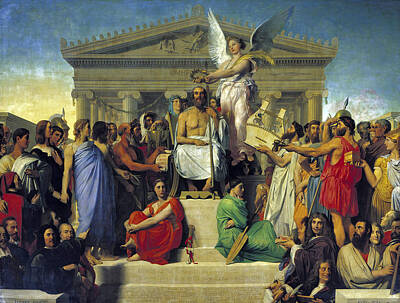.
Part 1 of Apotheosis of Homer
One must copy nature always, and learn how to see her rightly. It is for this that one should study the antique and the great masters, not in order to imitate them, but, I repeat, to learn to see. Do you think I send you to the Louvre to find there what people call "le beau idéal," something which is outside nature?
It was stupidity like this which in bad periods led to the decadence of art. I send you there to learn from the antique how to see nature, because they themselves are nature: therefore one must live among them, and absorb them. It is the same in the painting of the great ages. Do you think, when I tell you to copy, that I want to make copyists of you? No, I want you to take the sap from the plant. Ingres.
Buy Fine Art Prints | Greeting Cards | iPhone Cases | Tote Bags | Clothing | ...
Apotheosis (αποθέωση): The elevation of a person to the status of a god.
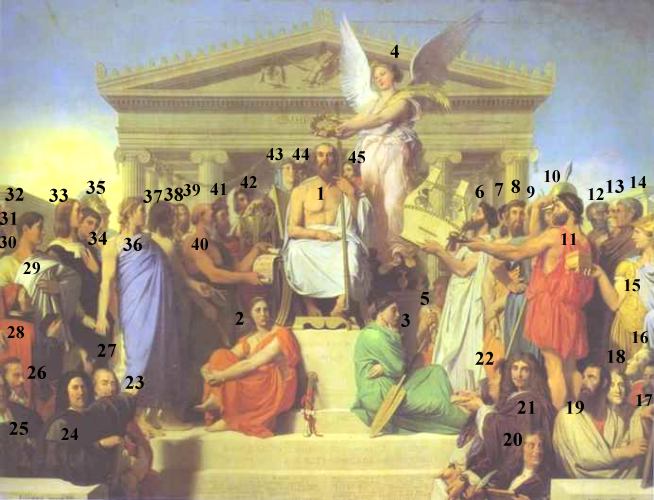
The Apotheosis of Homer , 3.86 m x 5.12 m (produced for the Louvre Paris), 1827, Jean Auguste Dominique Ingres (29 August 1780 Montauban - 14 January 1867 Paris), French Painter. A work probably inspired by Raphael's The School of Athens. In 1806 Ingres was in Rome where he saw Raphael's Frescoes of the School of Athens and The Parnassus.
Homer is the central person, with a godlike status he is made immortal (apotheosis) surrounded by the important persons of European culture. Here we have the great men of ancient and modern times in the realms of literature and the arts. Apelles holds the hand of Raphael, Dante is close to Virgil, Plato next to Socrates. Also supporters of the Greek culture are seen such as Peisistratos and also Alexander the Great who admired the work of Homer. Whereas Raphael used mainly portraits of his friends or other personalities of his time Ingres tries to be as realistic as possible using information from sculptures of the persons included in the Apotheosis of Homer. Scholars call this work an academic piece of art, nevertheless Ingress influenced the work amongst other of Edgar Degas, Pierre Auguste Renoir, Henri Matisse and also Pablo Picasso. We can consider this work also as “a visualization of knowledge”.

1) Homer

2) Iliad
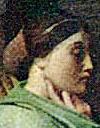

3) Odyssey (and a separate study)

4) Angel or Nike

5) Aesop
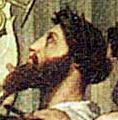
6) Pindar (in a separate study of Ingres Pindar is shown with Iktinus (or Ictinus) one of the designers of the Parthenon)
![]()
7) Hesiod (the author of Theogony and Works and Days)

8) Plato
![]()
9) Socrates

10) Pericles
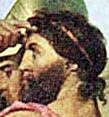
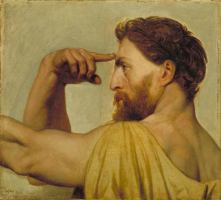
11) Pheidias, Sculptor of the Zeus Statue, Athena Parthenos, and a separate Ingres study,

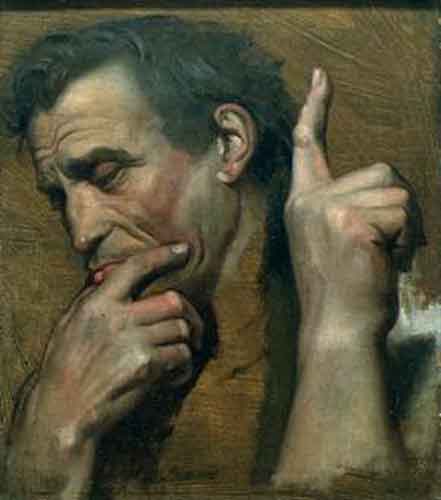
A study by Ingres of Michelangelo, Louvre Paris, Photo credits AKG London. (Image provided by Jahelle)
12) Michelagniolo di Ludovico di Buonarroto Simon, better known as Michelangelo, 6.3.1475 - 18.2.1564. Sculptor, Painter, Architect, Vatican
![]()
13) Aristotle

14) Aristarchus of Samothrace (Αρίσταρχος ο Σαμοθράξ) (160-145 BC) (not the Astronomer Aristarchus of Samos but the Grammarian, library of Alexandria ) known for his notes and comments on the Iliad and Odyssey

16) Christoph Willibald von Gluck , 1714 – 1787, Musician (Composer) from Austria, Alceste, Orfeo ed Euridice. http://home.prcn.org/~pauld/opera/18cent03.htm

17) Luis Vaz de Camoëns, 1524 –1580, author from Portugal, Lusiadas

18) Fenelon, 1651 – 1715, French Author, Bishop
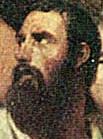
19) Longinus

20) Nicolas Boileau-Despréaux, 1636 –1711, French Author ( Detail )
Archelaos and his work: The Apotheosis of Homer
| Ancient Greece
Science, Technology , Medicine , Warfare, , Biographies , Life , Cities/Places/Maps , Arts , Literature , Philosophy ,Olympics, Mythology , History , Images Medieval Greece / Byzantine Empire Science, Technology, Arts, , Warfare , Literature, Biographies, Icons, History Modern Greece Cities, Islands, Regions, Fauna/Flora ,Biographies , History , Warfare, Science/Technology, Literature, Music , Arts , Film/Actors , Sport , Fashion --- |

